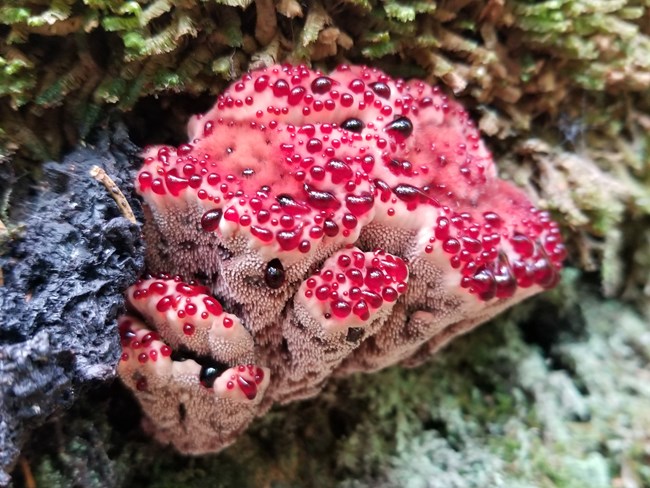
NPS Photo/Lilly Anderson Fungi’s RoleAcadia National Park is often appreciated for its stunning landscapes, forested coastlines, and unique patchwork of trees. Driving all the biodiversity and life we see above ground, from the towering old growth trees to the wildflower fields, is an underground web of fungal life. The more commonly known function of fungi is that they are decomposers; some break down dead matter into nutrients to be used by new growth. They provide another, lesser known link in the web of life as well. 95 percent of plants form partnerships with fungi through their roots. The fungi act as messengers within a forest through these relationships, allowing trees to send nutrients and warning messages to each other. Forests act as a whole with fungi as the thread connecting all the pieces together. 
NPS Photo/Lilly Anderson Mushrooms in AcadiaAcadia is a wonderful place to find and appreciate a variety of these forest floor gems. The best time to look for mushrooms in Acadia is from the early summer through early fall. Wet areas like wetlands, pond edges, and streams can produce exciting finds, especially a few days after rainfall. Although most mushrooms have a short life span, there are a few species that can be found commonly in Acadia year-round:
Some common seasonal finds include:

NPS Photo/Lilly Anderson Rare FindsBleeding tooth fungi are a more rare spooky species with an underside that looks like teeth, and a soft pink top bubbling up with a red liquid that looks like blood. This fungus find can happen in old growth forests, where the bleeding tooths like to trade nutrients to pine trees for sugar. Lobster, a Mount Desert Island staple, can also be found in mushroom form popping out through mossy understories beneath hemlock trees. Lobster mushrooms are a product of fungal cannibalism; the outer red shell is a hypomyces fungus parasitizing some other mushroom. Above and BelowMushrooms are simply the fruit of a fungus, and only reveal themselves to us under the perfect conditions. Seeing them often comes down to being in the right place at the right time. Even if you don’t see any of these mushrooms above ground in your exploration of Acadia, there is still a vast web of fungal life underneath your feet—recycling life and sending messages throughout the forest. 
NPS Photo by Jack Byrley Slime MoldAmorphous, bright yellow, and frequently seen in damp weather, slime mold can be quite baffling to the unfamiliar viewer. In spite of its name, slime mold is not, in fact, a mold. It is not a fungus at all, nor is it a moss, algae, or lichen. |
Last updated: October 19, 2023
